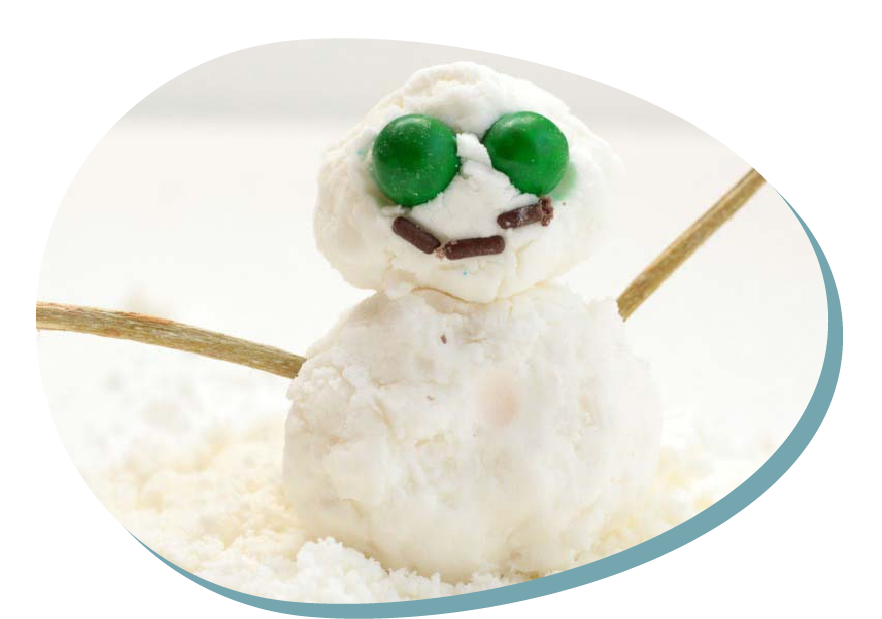Make a Snowman in the kitchen
Type of resource: website, guidelines
Web address https://preschoolsteam.com/create-fake-snow/
Language: English
Description
Creating fake snow and building a snowman and other figures with ingredients found in the kitchen.
Scientific concept introduced
Properties
Mixtures
Measures
Real snow
Fake snow
Creative and critical thinking
To observe what can happen and discover a way of making fake snow.
Taking initiative, building things from the snow.
Mathematical reasoning
To measure the ingredients.
Scientific thinking
To ask questions, to experiment, to discuss and test hypothesis.
Learning how to learn
Coping with stress and negative feelings.
Motivation to learn and engage.
Additional
Taking common decisions
Following the safety rules and discipline
Fine motor skills, hand-eye coordination
Vocabulary
Make a Snowman in the kitchen
Overall aims
To learn about snow and how different ingredients mix to obtain different properties.
To develop the ability to observe and discover
To create and build a snowman
To improve children’s problem-solving ( take initiative).
To create the learning opportunity for explaining how snow is produced/created
To improve their active listening (explanation of the the snow)
Vocabulary – keywords should be understood
Snow, cold, snowman, nose, arms, eyes
Expected learning outcomes (operational aims)
To explain how fake snow is produced or created.
To build a snowman with the product.
To calculate the proportion of the two parts of the snowman’s body to build it.
STEM skills – to which the learning unit is related to
CORE STEM SKILLS
● Asking questions.
● Designing experiments.
● Measuring and classifying.
● Conducting research-predicting, testing hypothesis, observing, experimenting.
● Motivation to learn and engage.
● Self-discipline and self-regulated learning (cognitive autonomy).
ADDITIONAL SKILLS
Sharing ideas
Hand-eye coordination
Taking common decisions
Basic literacy- listening with comprehension
Teaching methodologies/activity outline
1- Make an explanation of the snow.
2- Ask questions such as- Is snow cold? How do you think snow creates?
3- Give them the materials
4- Mix the different ingredients to create fake snow
5- Build the fake snowman following this process:
• Mix 1 cup baking soda and 1 cup cornstarch in a bowl.
• Add a tablespoon of water and mix with your hands.
• Continue adding water until the mixture is molded by hand. If you add too much water, it will liquefy. If this happens, you can always add a little more baking soda.
• Add cornstarch to the mixture to help keep the snow in shape.
• Once we have fake snow, children can make shapes and build a snowman. Use sticks, candies and other small toys to build snowmen in the same way you would in real snow.
Assessment of learning
Initial evaluation
– Get to know the previous knowledge they could know about the same theme.
Continued evaluation
– Think, create, elaborate explanations and start the basic mathematical skills.
– Observe and explore the immediate, natural and physical environment, with an attitude of curiosity and respect and gradually participate in social and cultural activities.
– Use the oral language, gesture and images to express ideas, desires, feelings and emotions; Listen and participate actively in regular situations.
– Conversation and learning with the use of non-discriminatory language, and with attitude of respect towards other cultures and different languages.
– To be able to listen, observe, interpret and create in the different languages: verbal, body, plastic, musical, and mathematical audiovisual, and incorporate the introduction to technological instruments (ICT).
Final evaluation
– To evaluate the learning objectives, use the previous operational aims.
Equipment and materials to be used in learning unit (tools, ingredients etc)
● Bowl
● Large play tray
● Measuring cup
● Baking soda
● Corn starch
● Stick
● Tablespoon
● Candy
Kind of setting
Preeschool room, kitchen
References – source
Make a Snowman in the kitchen
1. Usefulness for STEM education – integrating content of different disciplines
Cross-curricular character of the resource

The range of S-T-E-M subjects included

The presentation of possibilities of including artistic activities (STEAM approach)

2. Expected learning outcomes
Consistency (links) with preschool core curriculum

Communicativeness of description

3. Methodology of teaching
Clarity, communicativeness of instructions for teachers

Meaningful learning – using practical life problems

Original idea

The level of ease in implementing the methodology to preschool age children

The level of ease in preparing necessary ingredients, materials and equipment needed

4. Sustainability
Ecological characteristics of materials/ results

Supporting healthy eating habits

Relation with local traditions of cooking (using local products)

Low ecological footprint

Possibilities of inclusion (respecting cultural diversity and food intolerances)

5. Class management
Using differentiated forms of work – individual, team work etc.

Individual work

Team work

Whole group
6. Time management

Short activity (10-15 minutes)

Medium activity (20-30 minutes)

Long activity (1 hour or more)

Very long activity (1 day or more)
PDF: https://www.printfriendly.com/p/g/xKUsnn

